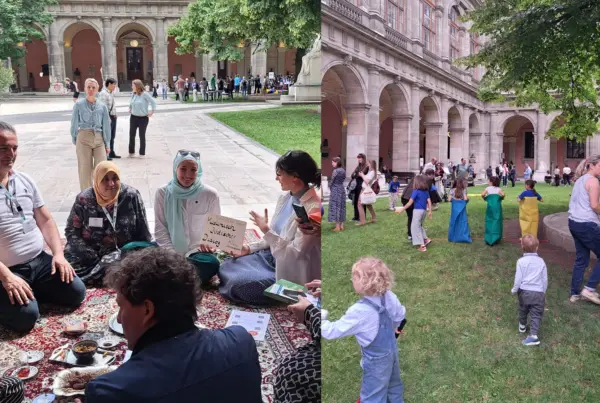As populations especially in Europe are living longer and staying young and healthy, the inevitable question arises: How can the economy continue to tap into this valuable resource? Age-discrimination by employers and society at large should be relegated to the past. A new study by Epunkt has highlighted the benefits of keeping the 55+ generation in the workforce longer. Retaining more 55+ in the workforce cushions the effects of an ageing population on the welfare state, increases GNP, reduces social tension, and promotes happiness.
Michael Thake, 4 August 2023
Growing silver streaks need not be all doom and gloom. According to the Zukunftsinstitut (a German think-tank specialising in understanding megatrends in sociology), an age-diverse team, which includes generation-55+ employees is more productive and experienced, offers better know-how and far more mentoring opportunities, has a higher emotional intelligence, increases identification with the company and has a better grasp of the generation-55+ consumer group than a less age-diverse team. Moreover, as the world is starting to get older, attitudes towards age and work are changing.
EU Commission figures reveal a growing uptake of generation-55+ workers in the Austrian labor market, where the employment rate for people aged 55-64 years has more than doubled between 2004 and 2019. Yet despite this reality, as well as the growing financial attractiveness and mental health benefits of working longer and more flexibly, 55+ workers still suffer from age-based biases by Austrian business leaders and HR representatives.
Epunkt, an Austrian based recruiting agency with 20 years of experience, published a study “Megatrend Silver Society: Why 55+ Professionals are worth their weight in gold for Companies” outlining the challenges people aged 55 and above face when re-entering the workforce and the benefits they bring to their companies.
To understand this dichotomy, Epunkt asked 103 business leaders in Austria whether their business currently offered employment opportunities for the 55+ generation (55+). The study found that 54 % of respondents said that they did not create such opportunities, whereas only 38 % of the respondents did. Negatively inclined respondents went on to argue that the 55+ generation were unemployable either because they were too expensive (35% of respondents), too inflexible and lack resilience (30%) or take sick leave for prolonged periods (13%). In addition, the remaining 22% felt that the 55+ generation had either a low job retention period (the amount of time a person stays in a given job), did not fit the team, were legally too protected against dismissal, or would find absorbing new technical information difficult.
Despite the fact that collective agreements for younger professionals are indeed cheaper, the myths persist that 55+’s take longer sick leave and have weaker sensory and motor skills in comparison to their younger peers. The Public Employment Service Austria (AMS) board member Johannes Kopf rebuffs these mainstream myths stating that “only the prejudices have aged.”
In a study conducted by economists Magnus Carlsson and Stefan Eriksson in the journal Labour Economics, 6000 fictitious applications were sent to various open vacancies throughout Sweden. The goal of the study was to ascertain if Swedish employers discriminated against older applicants, measured by the outcome of responses from employers in the form of call-backs to the applicants (e.g., invitations to job interviews). The results of the study show a substantial decrease in replies for applicants over 40 years. The discrimination against older people is so “substantial”, says Eriksson, that it even exceeds discrimination on the basis of ethnicity.
Regrettably, Austria still maintains age-based prejudices in recruitment. A survey 2022 Epunkt study revealed that only 2.7% of vacancies were filled by people 55+. These individuals were invited for an interview only after repeatedly requesting an interview for the applied position, or if the vacancy only attracted a small applicant pool, or if a specific skill for the role was required.
Due to advances in medicine and healthcare, the 55+ generation is fitter and healthier than at any point in modern history. Researcher and sociologist on aging, Professor Ursula Staudinger, argued during her keynote speech at the The Heidelberg Academy of Sciences and Humanities (titled: „Altern: Biologie und Chance”, transl. Aging: Biology and Opportunity) that today’s 70-year-olds are as functionally healthy as a 60-year-old only a generation ago, marking a paradigm shift in the way Austria should perceive the nexus of age and work.
More interestingly, 55+s are far more tech-savvy and open to reverse-mentoring schemes, which create new opportunities to exploit the social media and influencer landscape. According to Jennifer Jordan and Michael Sorell, reverse-mentoring schemes are successful by paring older, more experienced employees and younger employees. Reverse mentoring “… provide Millennials with the transparency and recognition that they’re seeking from management” (Harvard Business School Review, 3 October 2019, “Why Reverse Mentoring Works and How to Do It Right”).
Personalities such as Apo Whang-Od, a 106-year-old tattooist in the art of Batok, or Lyn Slate, a 69- year-old model from New York, not only landed on the cover of Vogue magazine and became the face for Valentino and Mango respectively, they also influenced the 55+ audience on social media sites usually dominated by their younger peers. Not only do influencers such as Whang-Od or Slate attract older potential customers to utilise social media and increase their expertise, but their activities also unveiled new and underappreciated niche markets.
The AMS has invested EUR 200 million into Austrian programs that enhance inclusion, part-time opportunities, and reskilling initiatives, while also reducing frictions concerning wage labour costs, in order to increase the employability of the 55+ generation. Perhaps local institutions are finally realising the importance of tapping into untouched labor gold.
The fact that Europe’s population is ageing rapidly will have direct implications on the constellation of the labor market and on the future of the social welfare state. According to the EU Commission, the number of Europeans over 65 will double within the next 50 years, while the number of those over 80 will triple over the same period. On average, the EU Commission’s 2021 Ageing Report finds that the old-age dependency ratio (which is the ratio of dependents – defined as people younger than 15 or older than 64 – to the working-age population) will decrease from 2.9 potential workers per dependent in 2020, to 1.7 in 2070.
Younger Europeans will have to work longer and be more flexible. In addition, the pension age will have to rise to reflect the realities of longer life expectancy and the need to finance the social welfare and pension system. A battle which President Emanuel Macron is currently facing in France, a country with one of the lowest pension ages in Europe. Retaining more 55+ in the workforce can cushion the effects of an ageing population on the welfare state and potentially reduce millions in healthcare expenditure.
Labour market squeezes, Artificial Intelligence-based redundancies, stagnant real-wage growth and high inflation, as well as a surplus in highly qualified and educated young individuals, already exercise enormous pressure on young workers and their wages. A balance is needed between the interests of each group, including the need for the younger generation to accept working with 55+ and end age-discrimination, be more flexible in their training and job choice, and compromise on their notion of the work-life balance.
Businesses must decide how best to attain the employee-mix that satisfies their corporate culture and growth goals. However, as medical care and innovation improve, the private sector would be misplaced to neglect the potential of the 55+ workforce. Ultimately, the private sector, government and labor organizations must cooperate to prepare, plan and pursue initiatives that give all an opportunity to work, age gracefully and pursue their happiness in changing times.
Picture: Boss assisting her employee with documents. © Vadym Drobot







